|
Monday, April 2, 2012
Progress Notes
This week I will continue to honor those Miller Countians who fought in the Civil War as part of the Civil War sesquicentennial which is being honored throughout the state of Missouri. I chose the Witt brothers Jesse Marion Witt and William Jasper Witt as the subjects for this week. I have written their story in a previous Progress Notes as part of a long history of the Witt family.
From that previous Progress Notes I will place here the biography of Jesse Marion Witt written by Brumley native, Greg Huddleston:
Patch-quilt Soldier
Jesse Marion Witt (photo 01)
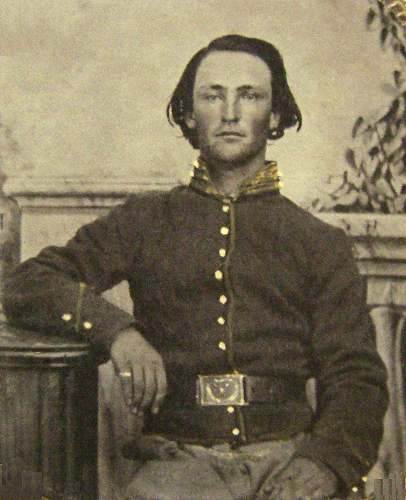
01 Jesse Marion Witt
By Greg Huddleston, Brumley, MO
Jesse Marion Witt was a Miller County Civil War veteran, serving in the Union army as private of the 6th Regiment Missouri Cavalier Volunteers. Captured by the enemy, arrested for desertion, his is an extraordinary story of a Brumley, Missouri farm boy who went to war barely beyond his teenage years. He left as a youngster but returned aged and worn, robbed of innocence. Like so many veterans of so many wars, it was to remain with him for the rest of his life.
Jesse was born near Ulmon's Ridge (now Ulman) on 22 Aug 1841, a simple farm life was his lot and he quickly became accustomed to the rigors and discipline of this existence.
Missouri was on the cutting edge, supplying sons to both causes. Some fought for the North, others for the South, and some only fought for their own interests, using the war to satisfy personal greed, lust, or vengeance. It was indeed an age of lost innocence... especially to Missouri and to her people.
It was amidst this fury that Jesse Witt reached adulthood. He observed his 20th birthday while in the service of the Missouri Home Guards, Osage Valley Regiment, Company D., Joseph W. McClurg commanding (photo 02).

02 Joseph Washington McClurg
The Home Guards were the Union's answer to the Confederate State Guards which had organized first and were using this advantage in attempts to threaten the local population into supporting the southern push for secession.
Near Brumley, at Camp Union, in May 1861, the formation of these Union Home Guard companies was the first sign of Federal military strength in Miller County. They were not organizing to merely fight for the Union, but against the Confederacy which seemed to symbolize nothing short of terrorism and murder.
Young Jesse joined the Home Guards at Brumley on 22 June 1861 and was assigned to Company D. By fall, the ranks became decimated as the patch-quilt soldiers became bored with military life. They soon began to drift away to their homes and families. Crops needed to be harvested, preparation made for the coming winter, home and hearth had to be protected from the marauding bands of guerillas still active in the area.
After Jesse had served his 6 months of duty with Company D he prepared to leave his native soil and quiet farm life again when he stated he wanted to join up and fight for the side that was going to win. He made his way south to Rolla and on 10 Feb 1862, enlisted for 3 years as a private in Company E Wood's Battalion, Union Rangers, Missouri Volunteers. The company mustered on 15 February 1862 and was sent south to Lebanon where the Union forces were gathering to move against General Sterling Price's rebels in Springfield (photo 03).
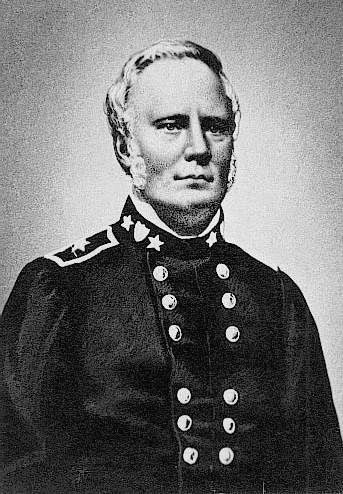
03 General Sterling Price
Within 30 days, Jesse Witt and the 6th Missouri Cavalry would be at the Battle of Pea Ridge in Arkansas.
After Pea Ridge, the Confederates faded away to the east across the Mississippi River into Tennessee and Mississippi to join forces with Lee's main armies. Missouri and Arkansas Federals began to strengthen their hold on the Ozarks in the absence of the rebels. On 14 Dec 1862, 24 men of the 6th Missouri Cavalry were captured near Helena, Arkansas and Jesse Witt was among those taken. Fortunately for Jesse his capture did not last too long... on 21 December 1862, he was in a prisoner of war exchange and was back with his troops by the 27th. However, in February 1863, Jesse mistakenly was listed as absent without leave for the period he was a prisoner and in March was listed as a deserter. On 25 Sep 1863, he was arrested for desertion and on the 29th was delivered to the military prison at Jefferson City. It is unclear where Jesse spent the next year of his life. It is possible he languished in a military prison. However his name appears as being present on all company rolls after October 1863.
Note: This bureaucratic error caused Jesse great emotional distress and affected him the rest of his life.
In 1865, Jesse was part of a brigade of 7 companies attached to the District of Baton Rouge, Louisiana. There is no further explanation why they were on a detached service in July 1865, because the war had officially ended in April when Lee surrendered at Appomattox.
Jesse returned to Miller County in September 1865. By spring he began to pursue the dreams he had left behind that cold February day in 1862. On April 1, 1866, he married Martha Ann Luttrell. That winter their first child arrived. Little Hamen Witt was the first of six children to bless the marriage as the years went by (photo 04).
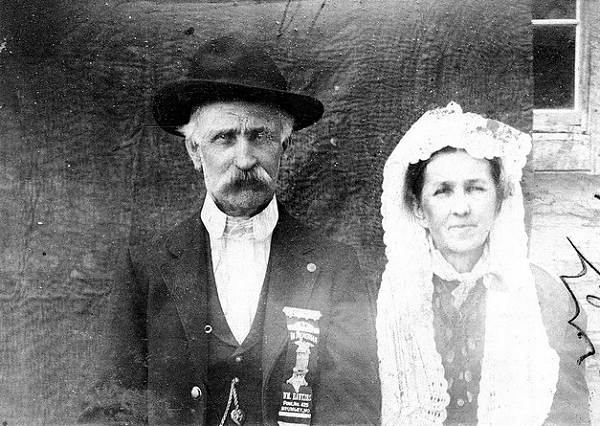
04 Jesse Marion and Martha Lutrell Witt
His inability to perform prolonged manual labor worsened with age and prompted him to seek medical aid early in 1879. In 1890, Jesse filed for a disability pension. He was granted $2 per month. From stories told by his granddaughter, Verdie Witt Shelton, I believe he spent most of his final years with her family.
Jesse Marion Witt now rests in the Mount Union Cemetery southeast of Brumley. One can stand at his gravestone and survey the land he knew so well and travelled so often, now owned by his great-grandchildren and great-great-grandchildren. The battles of the Civil War ended in 1865, but the war was never over for Jesse. Perhaps he has finally found the peace denied him in life... one can only hope.
Thanks Greg.
The following obituary of Jesse Marion Witt from the Autogram offers more information about his family:
Jesse Marion Witt Obituary
The Miller County Autogram Newspaper, Tuscumbia, Mo,
Thursday June 23,
1932, Page 3, Column 6
The Death Angel has visited our home again and taken from our midst another loved one. Jesse M. Witt was born August 22, 1841; departed this life May 31, 1932. He was united in marriage to Martha A. Luttrell April 23, 1866; to this union was born seven children, namely: George Witt of Marionville, Mrs Ruthie Drouillard of Terminal Island, Cal. Mrs W.T. Luttrell of Montreal, Mrs Frances Drouillard (deceased ) Haman Witt, Tom and John of Brumley. Two have preceded him to the great beyond. He was a soldier of the Civil War. He enlisted in Co D 6th Mo cavalry in 1861 and served till 1865, but the greatest of all, he was a true devoted and faithful soldier of the Cross till death. He was set for the defense of the gospel, ready and eager to give a reason for the hope within him; his utmost desire and ambition in life was to be a Christian. He obeyed the gospel early in life. He was 99 years, 9 months and 9 days of age when the loving father saw fit to remove him from earth and earthly cares and from the evil which so often vexed his righteous soul.
Our lives cannot tell we miss him; our hearts cannot tell what to say; God alone knows how we miss him, in a home that is lonesome today. He will sadly be missed by us all.
Funeral services were conducted at the Mt. Union Cemetery by Rev. V.M. Smith where the remains were laid to rest to await the resurrection.
Written by a loving granddaughter.
Malinda Jane
The biography of William Jasper Witt, brother of Jesse Marion Witt, is incomplete regarding his early life and service in the military. We do have this document indicating he was a member of the 47th Regiment in 1864 with Iberia given as his residence then (photo 05).

05 Civil War Record and Web Sites
Click image to view complete document in PDF format
Here is a later photo of him and his wife, Sarah Jane Thornton Witt (photo 06):
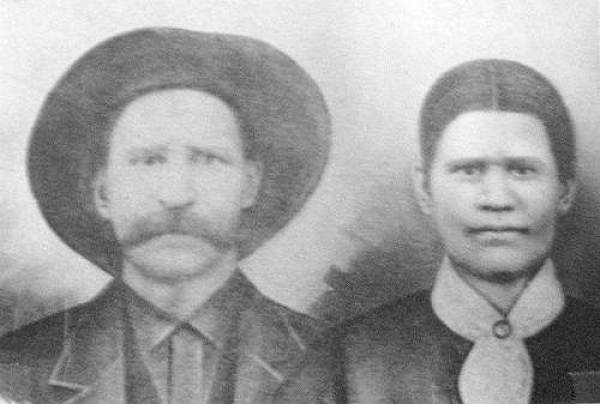
06 William Jasper Witt and Sarah Jane Thornton Witt
However, William is remembered because of the tragic manner in which he lost his life in a ferry boat accident. The newspaper story below describes the details of the accident:
WILLIAM JASPER WITT
From: The Miller County Autogram, 26 Feb 1891
"William Jasper Witt, one of Ira T. Johnson's assistants on the ferry boat, met with an accident about 3:30 Monday afternoon from which he died about 11 o'clock that night. The ferry boat is rigged with a windlass at either end of the boat for the purpose of heading the boat upstream (photo 07).
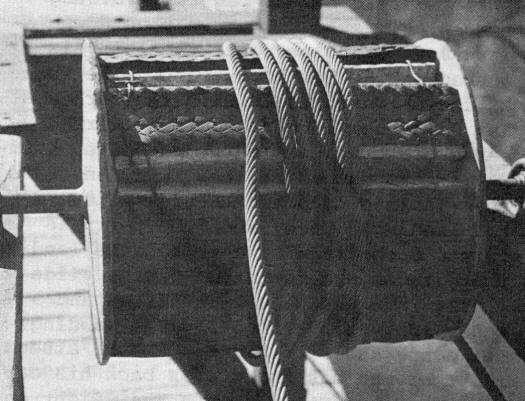
07 Ferry Windlass
When the river is high, as at present (1891) these windlasses are very hard to work, requiring a strong man to handle them.... The accident happened on the south bank of the river during preparations to return to this side. In turning the windlass, the iron handle slipped out of his hand and coming over, struck Mr. Witt almost on the top of the head, crushing his skull fearfully..... He was taken into Johnson's drug store where Dr. James B. McGee dressed the terrible wound (photo 08).

08 Dr. James McGee
Before this was completed, the injured man became unconscious and remained in that condition until death..... The remains were buried at the Scott Graveyard (upriver from Tuscumbia) on Wednesday. Witt leaves a wife and a large family of children."
Here are two photos of the ferry landing at Tuscumbia taken from the south side of the Osage River near where William Jasper Witt was killed (photos 09 and 10).
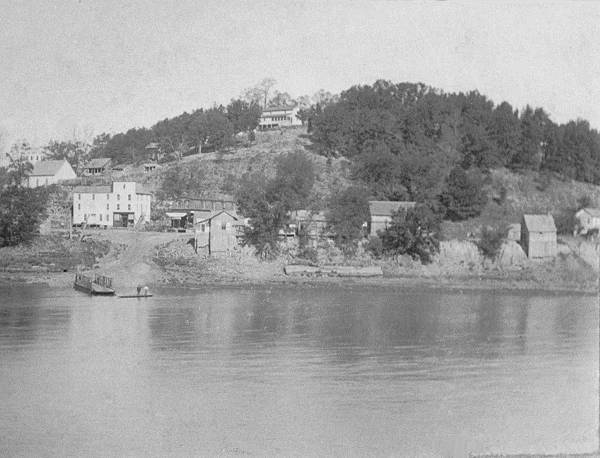
09 Ferry Landing at Tuscumbia looking North across the River
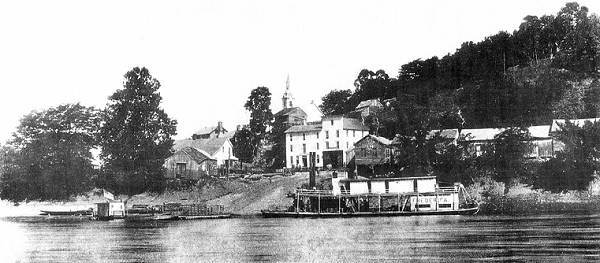
10 Steamer Frederick at Tuscumbia Landing
The entrance to the Scott Cemetery is featured in this recent photo (photo 11):

11 Scott Cemetery
Some further information about William Jasper Witt’s burial at Scott Cemetery was found on the “Find a Grave” website:
“He may be in an unmarked grave with no tombstone.
He first married Forbia N. Nicholas on 13 May 1866 by Andrew Brockman, a justice of the peace. In 1870 he and his family lived in Glaize Township near the families of Wyrick, Wickham, Witt, Renfrow, Myers, Casey, and Winfrey.
Sometime prior to 1877, his wife, Forbia/Ferby, died and on February 22, 1877 he married Sarah J. Thornton. Their marriage was performed by Hezekiah Robinett, a justice of the peace in Glaize Township. In 1880, they were living in Osage township near the families of Wyrick, Patterson, Hill, Lupardus, McCummins, and Topping.”
As noted above, you can read more about the Witt family, and especially about Jesse Marion Witt, at the previous Progress Notes I cited above.
The ferry at Tuscumbia was quite busy before the first bridge, a swinging bridge, was built in 1905 by Joe Dice (photo 12).
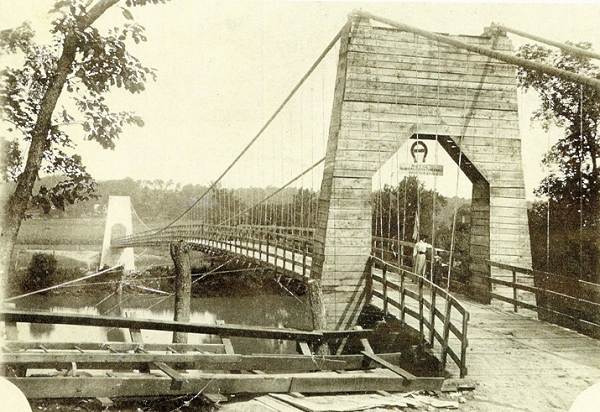
12 Swinging Bridge at Tuscumbia - 1905-1934
An undated clipping from the Autogram written probably in the early 1900’s tells more about the old ferry at Tuscumbia:
Old Ferry Landing At Tuscumbia Was Scene of Many Tragedies
Quite a number of exciting episodes and tragedies transpired at the old ferry landing. Among these might be mentioned the double drowning May 14, 1886 when T.P. Barrett and Richard Higgins lost their lives while assisting in the raising of the ferry cable; the capsizing of the ferry boat. August 26, 1890, when John Weitz, Bob Sullivan and William Witt narrowly escaped with their lives, and 31 head of cattle drowned; and the accidental death of William Witt, the ferryman, February 23, 1891. The fatal shooting of Alee Colvin, occurred on the south bank of the river in the nineties, when Colvin was assaulted by the Williams brothers as he was going home from town.
Following is the Autogram account of the drowning of Barrett and Higgins:
“A sad accident occurred here last Friday morning (May 14, 1886) at about 9:30 o’clock which cost the lives of two of our citizens and cast a gloom over the quiet little city when it was announced that T.P. Barrett and Richard Higgins had been drowned in the river by the capsizing of a skiff. The Gram (Autogram) reporter was soon on the spot and from eye witnesses to the sad scene, we gathered the following particulars, which are about correct: Friday morning had been set by Mr. Johnson as the time for re laying his ferry cable which had been torn loose from its fastenings on the north bank of the river by driftwood during the recent rise…and it was decided that the best way to do this was to use the skiffs…four in number…as a sort of buoy to hold the wire out of the water while the Steamer Frederick was to tow the lower end of the line to the north bank of the river. Bartlett and Higgins occupied the skiff next to the crick. None of the other skiffs had occupants. The position of Barrett and Higgins’ skiff was about third way across the river from the south bank. Both men were sitting in the bow while the cable lay across in front of them. They were advised by several to get on the boat as their skiff might sink, but Mr. Barrett thought not and jokingly remarked that they would have a good ride, and kept his seat. The engine was set in motion which, together with the force of the current against the wire, caused the bow of the skiff to sink without warning to the occupants and the next instant they were both thrown into the river, and it is the opinion that they were disabled by the wire striking them when the skiff capsized. They were excellent swimmers and notwithstanding the fact that they wore heavy boots struck out for the south bank, swimming high, and everyone thought they would reach shore safely. Suddenly, they seemed to lose their self possession and commenced drifting out farther into the river. Mr. Barrett gave way first and disappeared; he rose immediately and sank to be seen no more. Mr. Higgins was some distance in front of Mr. Barrett and was struggling manfully.
At this time Captain Marshall was making heroic efforts to get to the men with the Frederick, but the swift current made his efforts fruitless (photo 13).
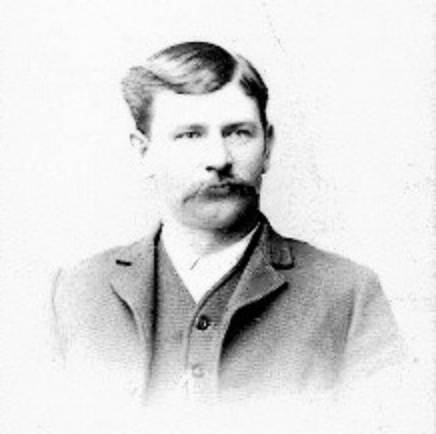
13 Robert Marshall
Mr. Higgins was urged to keep swimming, that help would soon be there. He replied that it must come soon as he was almost exhausted. Looking back he saw Mr. Barrett’s hat floating towards him, and giving one agonizing cry for help, sank beneath the water.
No one in particular is to blame, and no one more deeply deplores the sad affair than does Mr. Johnson; and he will spare no expense that the bodies may be recovered and delivered to their families.
Mr. Barrett leaves a wife and three small children almost wholly unprovided for, and Mr. Higgins a wife and two children who were dependent upon his daily labor for support. Both were hard working, peaceable men, attending strictly to their own affairs, and leave a large circle of friends who could not speak other than words of praise in their behalf.
Later, the body of Mr. Barrett was found by J.W. Hartgraves on Monday, about 11 miles below here near the “Devil’s Elbow” lodged in a drift. James Clark, U.S.G. Todd and Marion Frazier started after the body about 4 p.m. of that day and got back at 1 a.m. Tuesday morning (photo 14).
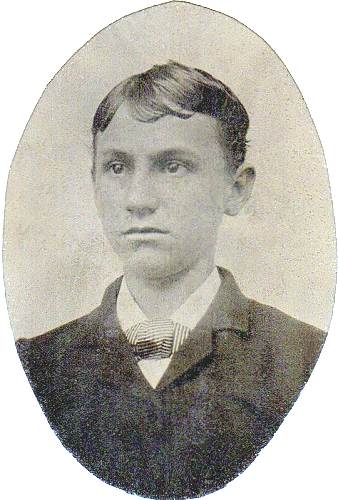
14 James E. Clark - Son of Joel B. and Eliza E. (Erwin) Clark
The face was black and swollen almost beyond recognition, the body having probably been floating for some hours. The body was taken to the Clarke building where it remained until 11 o’clock and was then carried to the cemetery and interred.
It was August 26, 1890, when Wilson Brothers, extensive buyers of cattle, drove up a large herd from South Missouri at the south ferry landing seeking passage across the Osage.
Tom Johnson was still proprietor of the ferry, and he had Johnny Weitz in charge, with Bob Sullivan and William Witt assisting. Most of the cattle had been brought across. Forty three head of cattle remained on the south side. Mr. Johnson was standing on the north shore watching the operations, and when Mr. Weitz informed him from across the river that there were 43 more cattle to bring over; Mr. Johnson told him to put them all on the boat. The fateful order was obeyed.
According to a reliable version of the affair, the boat was a new one, about 50 feet long and had been used by Captain R.M. Marshall with the Steamer Hugo in the transportation of wheat (photo 15).
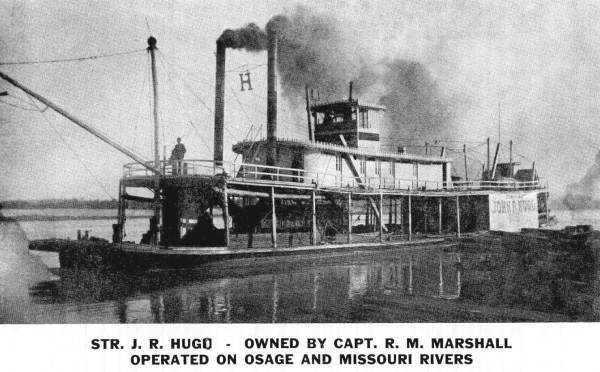
15 Steamer Hugo
Mr. Johnson bought the boat for the ferry. On one side of the boat was a guard, or walk way, outside the railing. For some reason, the side of the boat with this guard, which extended out from the boat, was turned up stream, and that was responsible for the capsizing. No sooner had the boat gotten well under way than the 43 head of cattle began milling about on the boat, crowding the upper side until the current caught the top of the guard. In an instant the boat had turned bottom side up. Sullivan and Witt escaped with little difficulty, but Weitz was caught underneath the boat between the banisters among all the cattle. He was almost drowned before he could extricate himself. He finally freed himself and came up near the side of the boat and was dragged up by his companions on top of the capsized boat, where he fell in an exhausted condition.
Thirty-one head of cattle, valued at $620.00, were drowned, and the damage to the ferryboat was $200.00. The carcasses of the drowned animals were towed to the bank and skinned, the 31 hides representing a small savings.
The events described in the article above indicate just how dangerous it could be to operate a ferry in high water or heavy wind storms.
Louie Clark Lawson, former columnist for the Autogram newspaper, wrote a detailed historical account of the Tuscumbia ferry:
Ferry Landing At Tuscumbia
Tuscumbia Autogram
2 November 1933
Louie Clark Lawson (photo 16)
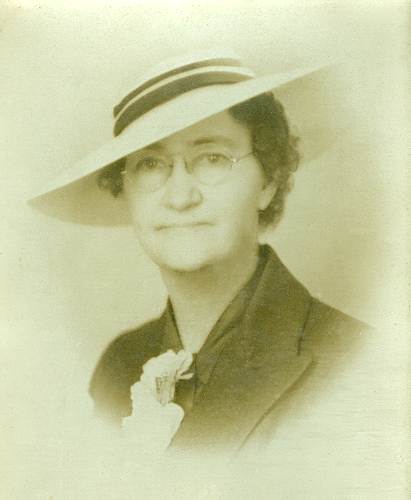
16 Louie Clarke Lawson
Our oldest residents recall that the ferry boat antedating the cable ferry was operated by two large oars, one on either side of the boat, and each oar was operated by two men. Then a third man handled the steering oar at the end of the boat. In order to make the landing on the opposite side, it was necessary, when the river was high, to row the ferry boat upstream along the bank some distance before striking out across the river.
About the year 1880 a cable ferry was inaugurated here. This cable was about one inch in diameter and was suspended across the river, over the top of supports 15 feet above the bank. The south end of the cable was stationary, but the north end was fastened to a windlass, which by means of a sweep, operated with man power, would wind up the cable to the proper tightness (see photo 07 of a windlass). A heavy chain was fastened to the end of the cable and a pin through one of the links held the cable. When steamboats approached the cable for passage up or down stream, it was lowered by knocking the pin out of the link and the cable fell with a splash.
At each end of the ferry boat was an apron, which was lowered when the boat landed so that a vehicle or stock could get loaded more expeditiously. At each end of the boat, which was about 40 feet long, there was also a windlass, and these windlasses were connected with the cable by means of two pulleys which traveled along the cable. By this arrangement, one end of the boat could be pulled up stream higher than the other, and the current pushing sidewise against the boat would propel it across the stream. This was hailed as a great invention and was really a big improvement over old methods.
The following article, again taken from a clipping from an old 1937 Autogram news article, gives information on what it cost to cross the Osage on the ferry boat.
Cornelius P. Davidson Was Granted The First License to Operate Ferry At Tuscumbia
Complaint was often heard that it is expensive to cross the Osage River but how would you like to pay the prices charged in 1937? In those days it was difficult, dangerous and tedious to cross the Osage River by ferry, especially when the river was in flood stage. That was even before Tuscumbia boasted of a cable ferry, the boat being operated by poles and oars.
The first man granted license to operate a ferry at Tuscumbia was Cornelius P. Davidson, August 8, 1937. For the benefit of those who would like to go back to “the good old days,” the rates Davidson filed with the county court are given as follows: wagon and six horses, $1.50; wagon and four horses, $1.25; wagon and two horses; $1.00; four wheel carriage, 75 cents; gig and horse, 50 cents; team of cattle the same as horses; man and horse, 25 cents; single horse, 12 ½ cents; footman, 6 ¼ cents; hogs and sheep, per head 3 cents; cattle, per head, 10 cents; baggage, per cwt. 10 cents.
Here is a list gathered by our museum staff of the names of some of the men who ran the Tuscumbia ferry in the late 1800’s:
Early Ferrymen
1865: John P. McCubbin
William Hauenstein
1866-67: William H. Waddle
A.J. Frazier
1868: Jerry W. Tallman
1869: Randolph Abbett
Alvin Rine
Daniel Cummings
William Hauenstein
William A. King
1872: William H. Waddle
Robert Masters
1875: William H. Waddle
1879: Charles Clark
Recently, we were delighted to have a visit from Lillian Fogleman Thomas and her two daughters, Susan and Marge Thomas, all of the Kansas City area. Here is a photo them in front of our museum (photo 17):

17 Susan, Lillian and Marge Thomas
Lillian is a granddaughter of Isaiah Bunker whose father, William Bunker, was one of Miller County’s first settlers. You can read about the Bunker family in the previous Progress Notes of March 5, 2012.
Here is a photo of Isaiah Bunker and his family which was included in that previous Progress Notes (photo 17a):
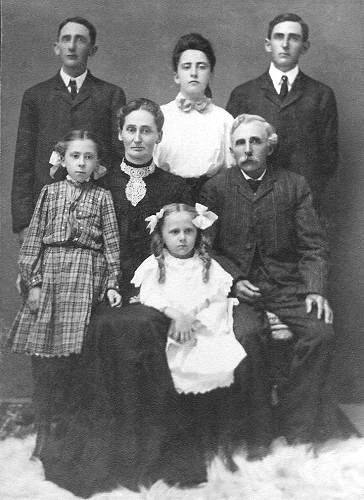
17a Isaiah and Marha Jane Mosley Bunker with Byron, Arie, Milton
Back Row: Ethel, Marha, Isaiah, Ellen - 1906
Lillian had kept a number of old farm tools which had belonged to her grandfather, Isaiah, and probably her great grandfather, William, as well. We were delighted that the purpose of her trip to Tuscumbia was to donate to our museum these old tools. Harold Flaugher, who is our newest board member, identified many of these tools for us. In this photo Harold is holding a device used to measure wagon wheel circumference (photo 18).
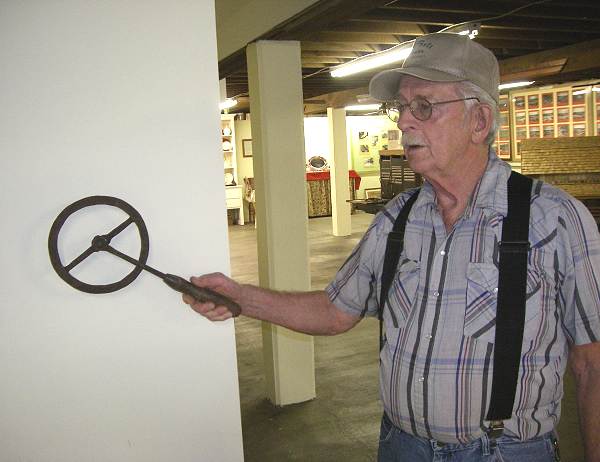
18 Harold Flaugher with Traveler measuring device for Wagon Wheels
Harold was able to identify all the following farm tools for us. Just click on the thumbnails to view a larger version. Putting your cursor over the thumbnail will give you a short description of the photo (photos 19 - 21n):
Some old ice cleats were among the items given; they strapped to the heels of the shoes to prevent slipping on frozen ground (photo 22).
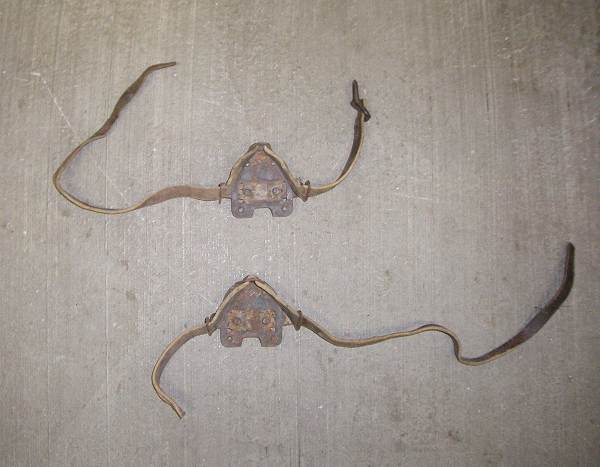
22 Ice Cleats
Other items of interest were a number of pieces made of linen, some crocheted clothing accessories, and a large handmade tool box.
Here is a photo of two hand made baby caps (photo 23):

23 Knitted Baby Caps
Lillian’s husband, Victor Thomas, had worked for the Rock Island Railroad out of Olean when they lived in Miller County. He had a number of historical items having to do with the railroad which Lillian brought along for our museum. Here is a photo of some iron nails used to fasten the iron rails to the ties which Victor collected from different train lines as indicated in his labeling (photo 24):

24 Three Railroad Spikes from Different Cities
Click image for larger view
Lillian and her daughters enjoyed a tour I gave them of our museum which I was happy to do. Because both Lillian and I were born and raised here we had much in common to talk about regarding Miller County and Tuscumbia history.
The following are a series of short items which have been collecting on my desk which may be of some interest:
Bertha Harris, daughter of Walter and Annie Doubikin, had a very large doll collection which she donated to our museum. The dolls were given the day the museum celebrated its move from the old jail to the Anchor Mill hardware store on Highway 52 north of town June 2, 1991. Here are a couple of photos of the dolls (photos 25 and 26):

25 Dolls

26 Dolls
I don’t have a photo of Bertha but here is her obituary which describes her very productive life
Obituary: Jefferson City Post Tribune, Saturday, April 21, 2001
Bertha “Bert” Doubikin Harris, 97, St. Elizabeth, died April 19, 2001, at Capital Region Medical Center. She was born July 3, 1903, in St. Elizabeth, a daughter of J. W. and Annie Shockley Doubikin. She was married July 16, 1952, in Swedeborg, to Fredrick Lee Harris, who survives at the home.
She was a graduate of Iberia Academy and Junior College and a graduate of the University of Missouri-Columbia. She was an elementary, secondary and adult education teacher for 34 years. She worked for the University Extension Service as the Pulaski County Home Agent.
She was a member of the American Association of University Women, Miller County Historical Society, Lake Ozark General Hospital Auxiliary, Missouri Farmers, Inc. and Oil Company and the Miller County and Missouri State Republican Party.
She was a Farm Bureau Political Action Trustee. She was a contributor to the Miller County Autogram and the New Iberian. She was the author of several books.
She was baptized at Fairview Christian Church, near Iberia, and was a member of the Bethel Baptist Church, Columbia. She was affiliated with and active at Berean Baptist Church, Richland, and St. Anthony Catholic Church, near Iberia.
Survivors include one nephew, John D. Hammons Sr., Sedalia.
Services will be at 2 p.m. Sunday at Rekus Funeral Home, Iberia. Brother Louie Martin will officiate. Burial will be in Livingston Cemetery, near Iberia. Visitation will be from noon-2:00 p.m.
Next are a couple of paintings by Janet Hix Buthold. Janet was the daughter of Byron and Ida Hauenstein Hix of Tuscumbia where Byron was an officer of the Bank of Tuscumbia for many years. The first painting is of the old swinging bridge at Tuscumbia built in 1905 (photo 27).
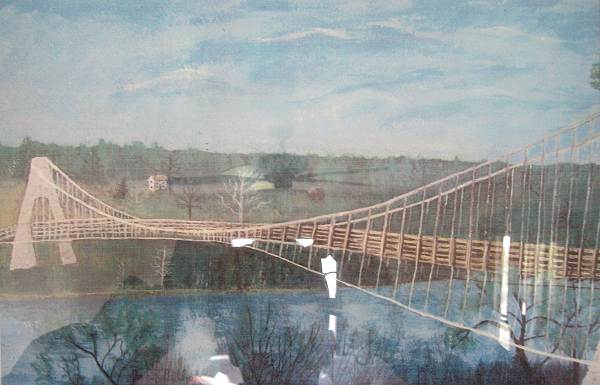
27 Swinging Bridge Painting
The second painting is of an old home in winter somewhere in Miller County (photo 28).

28 Cabin In Woods In Winter Painting
Janet told me she painted it by memory so long ago she doesn’t remember exactly where she found it!
The following photo of John Ferguson and Alf Eads I obtained with my camera from the Autogram microfilmed archives at Vernon Publishing Company (photo 29):

29 John Ferguson and Alf Eads - July 26, 1934 - Autogram
Click image for larger view
Next is a photo of an old river depth gauge located on the bank of the Osage River on what is now the Osage National Golf course (photos 30 and 31).

30 Osage River Gauge

31 Osage River Gauge
I called Tuscumbia native Alan Sullivan, an electrical engineer who now is an officer of the Ameren Company at Bagnell Dam, to give me some more information. Here is what he told me:
“This is the old Bagnell River Gauge house. I don't have any specific information on this gauge, as we have used USGS data from the Hwy 54 bridge gauge since that bridge was built in the early 1970's. This gauge station was discontinued, I assume (but don't know for sure) at the same time the bridge was built.”
I did some investigation and found that only three active water level gauges are active now on the Osage River. Thirteen of the original gauges are no longer in use and that includes the one at Osage National Golf course I would think based on what I read at this website:
USGS Gauging Stations
The USGS lists 13 discontinued and 3 active gauging stations operated to monitor stream flows and water quality in streams and rivers of the basin. Seven of these gauges were located upstream of Bagnell Dam in HUC 10290109, within Benton, Laclede, and Morgan counties. Six of the gauging stations were located downstream of Bagnell Dam in HUC 10290111, within Cole, Maries, Miller, and Osage counties. Descriptions of the three active gauges are given below.
Gauging station number 06922450 is located on the Osage River 2,000 feet downstream of Truman Dam near Warsaw, Missouri. This gauge was installed after the construction of Harry S Truman Reservoir and measures flow from an area of 11,500 mi.2. The available period of record is from 1981 to 2000, excluding October 1989 through September 1990. This station is important because it measures the majority (82% on average) of all water flowing into Lake of the Ozarks. (Real-time river stage data for the Osage River below Harry S Truman Dam at Warsaw, MO are provided by the USGS.)
Gauging station number 06926000 is located on the Osage River at the State Route 54 bridge, near Bagnell, Missouri. The station is 1.3 miles downstream of Bagnell Dam, which is located at Osage RM 81.7 and impounds Lake of the Ozarks. This gauge, which is jointly operated by USGS and AmerenUE, records flows from an area of 14,000 mi.2. Mean monthly flow data are available for 1880-1925. Mean daily flow data are available from 1925 to 2000. This station is important because it provides information on the flow regime prior to impoundment of Lake of the Ozarks. It also continuously measures the discharge from Bagnell Dam, which controls most of the water flowing into the lower 82 miles of the Osage River. (Real-time river stage and discharge data for the Osage River near Bagnell, MO are provided by the USGS.)
Gauging station number 06926510 is located on the Osage River below St. Thomas, Missouri at Osage RM 34.5, about 47 miles downstream of Bagnell Dam. This station was installed in 1996 and replaced gauging station number 06926500, which was about 9 miles upstream. Station 06926510 below St. Thomas records flows from an area of 14,500 mi.2. The available period of record is from 1931 to 2000. This station provides information on the combined discharge from Bagnell Dam and inflowing tributaries between Bagnell Dam and the station. (Real-time river stage and discharge data for the Osage River below St. Thomas, MO are provided by the USGS.)
Here is an old post card with an image of the Bank of Tuscumbia (photo 32):
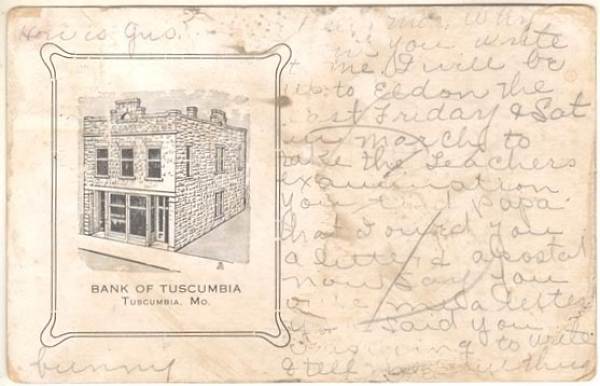
32 Bank of Tuscumbia Post Card
I don’t know to whom the card was sent or who wrote the note.
Next is an old photo reprinted recently from the Advertiser featuring some Eldon golfers with date unknown but I suspect it was in the late 1940’s or early 1950’s (photo 33).
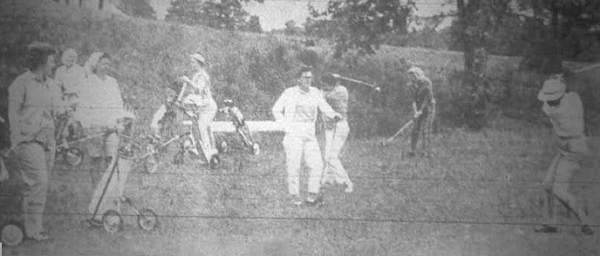
33 THE FIRST LADIES GUEST DAY of the season was held at the Eldon Golf and Country
Club last week. Local women looking on as a visitor tees off are Mrs. Clark Payne, at left,
and Mrs. Homer Abbett, in the center wearing white sweater. Taking a practice swing,
second from right, is Mrs. Arthur Bear.
The caption indicates the event was the “First ladies’ Golf Day.” It was of interest to me because one of the ladies, Mrs. Arthur Bear (maiden name was Lena Brown), was married to my Uncle Arthur Bear, brother to my mother.
We have a new feature added to our website which gives the history of the many steamboats which navigated the Osage River. It is a video with narrative and many many photos of steamboats. You can access it from the top of our Home page under the selection Yesterdays following this path (or just click on the link below to go directly to the steamboat site):
Yesterdays > Transportation > Steamboating (video)
Last I have a recent photo of one of the first redbud trees to bloom this spring taken on the museum campus in Tuscumbia with the old Lupardus Cabin in the background (photo 34).

34 Redbud Tree near Lupardus Cabin at Museum Campus
It seems as if the redbuds were early this year maybe because of the warm weather.
That’s all for this week.
 Joe Pryor
Previous article links are in a dropdown menu at the top of all of the pages.
|

